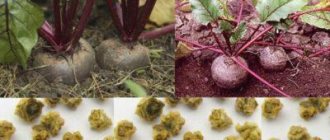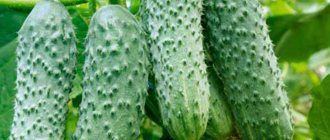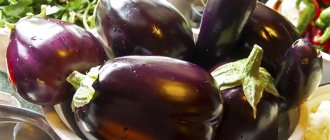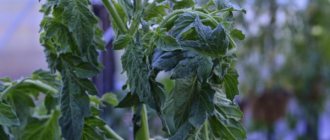Origin story
Table beet (Beta vulgaris L.ssp.vulgaris var. conditiva Alef.) Mulatto was obtained in the eighties of the last century by the Soviet breeder Sergei Vasilyevich Maksimov. Work on improving the variety continued until 2001 in the agricultural sector. Two years later, it was included in the register of breeding achievements of the Russian Federation and recommended for cultivation in most regions of the country, from the Volga-Vyatka to the Far East. Very quickly, Mulatto beets became widespread; they began to be cultivated in the CIS countries, the European Union, and the USA.
The popularity of the Mulatka variety is explained by the high quality of root crops and excellent transportability
Healing properties
Beetroot is known for a wide range of healing properties that are popular in folk medicine. Due to the content of various vitamins, beets are used to strengthen the walls of blood vessels, normalize heart function, prevent atherosclerosis, reduce blood pressure, and much more. etc. Beetroot can often be seen in the diet menu.
ADVICE: Hypertensive patients are recommended to consume a tablespoon of a mixture of beetroot juice and honey, diluted 50/50, every day immediately before meals.
Description of the beet variety Mulatka
At the stage of technical ripeness, Mulatka beets have rounded roots with smooth skin. Sometimes their heads can acquire a cork-like structure. The pulp is dark burgundy, without cylindrical rings. The average weight of the vegetable is 200-400 g. The axial root is small, purple in color. The oval light green foliage of the Mulatto beet forms an erect rosette up to 40 cm high. The petioles are crimson on the back side. The edges of the leaf plates are wavy, the surface is slightly bubbly.
The taste of the Mulatka variety is excellent. The vegetable pulp contains 14.5% sugar and up to 19.8% dry matter.
Beet roots have a high content of proteins, carbohydrates, vitamins, and microelements
Characteristics of Mulatto beets
The variety belongs to the table variety, it can be used in cooking, for preparations and winter storage.
The period from the appearance of the first shoots to harvesting is 130 days. The yield of Mulatka beets depends on climatic conditions and soil composition. When grown on farms in the Central Black Earth Region, it is 250-400 c/ha, in the Moscow region - 200-300 c/ha. The percentage of commercial output is high, up to 98%.
The frost resistance of Mulatka beets is average, its seedlings easily tolerate return frosts, and ripened root crops are resistant to sharp drops in temperature.
Mulatto is the best choice!
To obtain the desired result when growing beets, it is important to know what type of seeds is at your disposal. This is due to the fact that this root crop has three types of selection in terms of ripening: early, mid-ripening and late. The first one on the list is not suitable for storage in winter. The latter are quite suitable. Mulatto is one of the mid-season beet varieties. Its ripening period is about 120-125 days. After this time, you will be able to eat beets and make supplies for the winter.
The root crops of this variety are visually not much different from other varieties already familiar to us. They grow on average weighing up to 350 g, have a round shape and a smooth surface. The color of beets can be described as dark burgundy. Mulatto has earned praise from gardeners for its excellent taste, absence of rings and juicy pulp.
Another advantage of these beets is that they can be stored well during the winter months. If you decide that the variety in question is suitable for you, then you should take into account that planting should begin in the third ten days of April. There is also an option with winter sowing starting from the second half of October and ending at the beginning of November.
TIP: The planting depth should be about 3 cm. In this case, you need to leave a distance of 8-9 cm between the seeds. You should also provide row spacing approximately a quarter of a meter wide.
Advantages and disadvantages
Growing Mulatto beets is not difficult; it does not require special care and produces stable, high yields.
During storage, root crops do not wither, maintaining their presentation and beneficial properties until spring.
Among the advantages of the Mulatka variety:
- excellent taste;
- attractive appearance;
- absence of white rings in the root crop;
- preservation of the bright color of beet pulp after heat treatment;
- long shelf life;
- high transportability;
- color resistance.
Flaws:
- the need for good lighting;
- average resistance to pests and diseases.
Harvesting and application
The Mulatto crop is harvested before the first frost. Dig up the beets with a pitchfork, then clear the soil and lay them out on the garden bed. Next, cut off the tops, leaving a small petiole. For storage, smooth and beautiful fruits are selected, without scratches or rot.
Vegetables are best stored in wooden or plastic containers covered with film on top. The optimal air temperature for storing Mulatto beets is from 0 to +2 degrees.
The variety is used for preparing a wide variety of dishes. For example, a salad of garlic and prunes would be an excellent addition to dinner, and a festive table would be decorated with beet liver cake. Also very popular are beetroot salad with nuts, borscht, herring under a fur coat, and vinaigrette.
Plus, sweet and healthy desserts are prepared from beets: beet pancakes with fermented baked milk, chocolate pie with beets and nuts, beet pancakes.
Interesting! Beetroot is a universal home remedy. It has an anti-inflammatory, diuretic and wound healing effect. In addition, beets contain iodine, B vitamins, and minerals. Regular consumption of beets improves digestion and helps reduce excess weight. The vegetable is ideal for dietary and baby food. Beetroot also serves as an excellent remedy for the beauty of hair and skin.
Planting Mulatto beets
To get an earlier harvest of root crops, the seedling method is used, but most often beets are sown directly in open ground. Loamy or sandy loam soil is suitable for cultivation. If its acidity is high, wood ash or dolomite flour (600 g per 1 m2) is added in the spring.
Seedling growing method
The method allows you not only to obtain root crops a month earlier than usual, but also to avoid thinning the seedlings. In addition, Mulatto beets, obtained from seedlings, have a more stable immunity to disease and pests. They operate according to the following scheme:
- Fill the containers with a soil mixture of compost, humus, sand and sawdust mixed in a ratio of 1:1:0.5:0.5.
- Spread the beet seeds over the surface of the soil at intervals of 2 cm.
- Sprinkle with a thin layer of soil mixture.
- Moisturize.
- Cover the top with film, glass or a transparent lid and transfer to a warm place (+20 ⁰C).
- After the first shoots appear, the shelter is removed and the temperature is reduced to +14 ⁰C.
- Ten days before planting, the seedlings are hardened by exposing them to the open air, first for one hour, and a few days later for five to six.
- A week before, reduce watering of Mulatka beets, and a day before planting, moisten the soil with a solution of potassium chloride (2 g per 1 liter of water).
Important! High-quality seedlings have well-formed tops of four to five bright green leaves about 8 cm high and a developed root system.
Growing seedlings in a snail saves space and soil
Planting in open ground
Ready seedlings are planted after the threat of return frosts has passed. The soil should warm up to +10 ⁰С. For Mulatto beets, choose a sunny place without shade. Humus or well-decomposed compost (3 kg per 1 m2) and 30-40 g of complex mineral fertilizer are added to the soil. They dig to the depth of a bayonet and make ridges. The holes are placed at a distance of 5 cm. Their depth and volume should correspond to the size of the root system along with the earthen ball. Leave a gap of 25 cm between the rows.
Important! Seedlings cannot be kept in containers; the root may rest on the bottom, and later an irregularly shaped root crop will grow.
Mulatto beets are planted in cloudy rainy weather or in the evening. They use the transshipment method to preserve the integrity of the root system as much as possible. The holes are watered, after which the seedlings are transferred into them and covered with soil.
The root collar of the Mulatto beet should be located at the level of the ground surface
The seedlings are watered with a humate solution and covered with non-woven material for several days to protect the fragile seedlings from direct sunlight.
You can plant Mulatto beets in open ground with seeds (dry or germinated). Untreated planting material (brown or beige) is first placed in a saline solution and after a few hours those seeds that have settled to the bottom are selected. After washing under running water, place them for 12 hours in a weak solution of potassium permanganate for disinfection, and after that - for two hours in a growth stimulator (Epin, Zircon). The seeds are placed in a warm place for a day, where they swell and peck. Then proceed according to the scheme:
- Furrows 2 cm deep are made on the prepared beds.
- Water them.
- Spread the seeds at intervals of 2-8 cm.
- Cover with a thin layer of soil.
- Water carefully so as not to wash away the soil.
How to choose a beet variety for a specific region
The climate in the region is the first thing to consider when choosing a beet variety or hybrid. Selection does not stand still; varieties have long appeared that are specially adapted for the Urals, Siberia, and other areas with a sharply continental climate that is not very suitable for gardening. Those living in the southern subtropical regions are luckier. When choosing, they can focus solely on taste, yield, shelf life, and the presence of immunity to certain diseases.
Choosing the most suitable beet variety is not an easy task, especially for a novice gardener.
In central Russia, you can also plant almost any beet. Summers there are quite warm and the climate is moderate. Not only early varieties have time to ripen, but also late-ripening ones (their root crops form in September or even October). Winters here are most often not severe, so autumn sowing is also possible. Beet seeds are planted in late autumn, and they sprout in early spring.
Read more: President plum variety description - Garden and vegetable garden
Among the early ripening varieties, Pablo and Bordeaux are the most popular among gardeners living in the European part of Russia. The time-tested Cylinder does not lose ground either. For those who love sweet beets, Regala is suitable. Of the medium-ripening varieties, Egyptian Flat and Podzimnyaya receive invariably positive reviews; the late variety Odnorostkovaya is valued for its excellent keeping quality.
In the Krasnodar region, Stavropol region, Black Sea region and Crimea, varieties that are distinguished by high yields are most often planted. The mild, warm climate makes it possible to achieve the stated indicators. Gardeners also focus on taste. The most popular varieties here are Nosovskaya Ploskaya, Gribovskaya Ploskaya, and Mulatka.
Summer in the Urals is characterized by unpredictability in terms of weather. It often comes out quite cold. Therefore, it is better to play it safe and plant early varieties, for example, Smuglyanka, Egyptian flat. They ripen already in July-August, but the root crops are quite large. Of the mid- and late-ripening varieties, only cold-resistant ones are suitable for cultivation in the Urals, which will not be damaged by quite likely early frosts. The best among them are Slavyanka, Barynya, and Detroit.
Cold-resistant beets are also planted in Siberia and the Far East. Summer there is short and quite cool. There are varieties specially adapted for these regions. For example, Siberian flat, Northern ball. With proper care, they are not inferior in yield and taste to other varieties. A distinctive feature is very good keeping quality.
Choosing the right beet variety is the key to a bountiful harvest
One of the main criteria that a gardener focuses on when choosing is the ripening period of beets.
Early beets
Early varieties, when planted in early April, produce a harvest as early as July, and some even at the end of June. They do not differ in keeping quality; their taste cannot be called outstanding. The root vegetables are smaller than other varieties, weight varies from 200 g to 500 g. These beets are best suited for salads and making juices.
The high sugar content of root vegetables means they are suitable for processing. These beets are also very good fresh and for making juice. It can also be included in children's diets.
An ordinary miracle
A variety from the mid-season category. The taste of this beet is very balanced, the flesh is tender. Root vegetables are round or slightly flattened, weighing on average 300-450 g. Sugar content - 16.5-17.8%.
Ordinary miracle beets have a very balanced taste
A popular mid-season variety, specially bred for cultivation in Western Siberia and the Far East. The variety rarely suffers from cercospora blight, but for some reason the beet flea beetle has a special love for it.
Bravo beets suffer from beet flea beetle attacks more often than other varieties.
Root vegetables are almost round. The pulp is dense, but tender and juicy. Weight varies from 200 g to 780 g. The taste is excellent, the sugar content is very high (15.8–17.9%). The percentage of root crops rejected is no more than 2–8%. Productivity - 6.5–9 kg/m².
An early variety, however, it is also suitable for long-term storage. It is recommended to cultivate it in the Central region. Advantages include resistance to cercospora and flowering.
Kozak beets are resistant to cercospora blight and do not suffer from flowering
The roots are elongated, suberization is moderately pronounced. The weight of beets is 180–290 g, sugar content is 15.7%. The yield is not bad - about 7 kg/m².
Mulatto
The most suitable regions for cultivation are the Volga region, the Black Sea region and the Far East. The variety is widely used in cooking, but is also suitable for long-term storage. Mulatto is a mid-late beet. The harvest is harvested 125–130 days after seed germination.
Mulatto beets - a popular mid-late variety
Root vegetables are almost round. Suberization is absent or very weak. Average weight - 160-360 g. Sugar content is very high - 14.2-14.6%. The percentage of defects depending on care is 2–18%. The variety is valued for its keeping quality and transportability, not only by amateur gardeners, but also by farmers. It is also little susceptible to sudden temperature changes.
The best table beet varieties are distinguished by their balanced taste. They are suitable for fresh consumption.
Rival
Medium ripening variety. Valued for its high yield and excellent taste. Small dark red root vegetables with a diameter of only 4–6 cm and a weight of 200–300 g. The pulp is very juicy and tender. The variety is demanding when it comes to watering. Productivity is average - 4.5–7 kg/m².
To obtain a bountiful harvest, Rival beets need to be properly watered.
Andromeda F1
Early variety. The state register recommends for cultivation in the Black Sea region. Single-germ hybrid. The root vegetables are cylindrical, up to 6.5 cm in diameter, very large - more than 680 g. The pulp is very juicy, cooks easily and quickly, and does not lose color during heat treatment. As a disadvantage of the variety, susceptibility to diseases is noted - root beetle, powdery mildew, cercospora blight, all types of rot. This variety is also sensitive to cold. A characteristic feature is the inability to accumulate nitrates.
Andromeda F1 beets cannot boast of good immunity
A medium-ripening variety that very successfully combines the excellent taste of root crops with shelf life and high immunity. The root crops are cylindrical, reaching a mass of 320 g. Almost two-thirds of the beets stick out from the ground, this is normal. Productivity is approximately 7 kg/m².
The root crop of the Kedri beet sticks out of the ground by almost two-thirds
Opolski
Achievement of Polish breeders. Mid-season variety. In Russia, it is recommended for cultivation in the Black Sea region and the Central region. The roots are elongated, weight varies from 160 g to 440 g. They are half immersed in the soil. The variety does not suffer from Phoma blight, but can become infected with Cercospora blight. Productivity - 2.5–5 kg/m².
The greatest danger to Opolski beets is cercospora blight.
Black woman
Recommended regions for cultivation are the Volga region and the Far East. Medium ripening variety. Root vegetables are spherical, suberization is weak. Sugar content is 9.7%, but this does not affect the excellent taste.
Negro beets are not particularly sweet, but this does not affect the taste
The cultivation of this crop is carried out according to some extremely simple rules. The seeds of the Mulatto variety are sown in April. Many gardeners are accustomed to immersing planting material directly into the ground. But, as the practice of many summer residents has shown, growing beets using seedlings will be the most successful.
Read more: Turkey meat benefits and harms calorie content for weight loss
When cultivating this plant, it is recommended to choose the site wisely. Beetroot of this variety loves fertile and loose soil, in which the acidity level will be weak or neutral. It is recommended to prepare the soil in advance, starting in September. The area is weeded, dug up, fertilized and disinfected.
Before planting, Mulatto beet seeds are selected. It is recommended to soak them in a weak solution of manganese.
Mulatto beets usually produce a large harvest
“Mulatto” is a beet variety that is extremely easy to grow. Any gardener can cope with its cultivation. At the same time, the variety guarantees a bountiful harvest.
Caring for Mulatto beets
The main agrotechnical measures when caring for Mulatto beets consist of timely watering, weeding, loosening row spacing, and fertilizing. You should focus on weather conditions, condition and appearance of plants.
Watering, weeding, loosening
Despite the fact that Mulatto beets easily tolerate temporary drought, moistening should be carried out regularly, as the top layer of soil dries. At first, seedlings are watered every other day, later - twice a week. Irrigation is usually combined with subsequent weed removal, loosening, and mulching.
Important! For Mulatto beets, sprinkling in the evening is suitable, allowing not only to moisten the soil, but also to refresh the foliage.
To increase the sugar content of root crops, watering is stopped 2-3 weeks before harvesting.
Top dressing
The use of mineral fertilizers can lead to cracking of root crops and the formation of voids in them. To feed Mulatto beets, you should use organic matter - a solution of mullein infusion (1:8) or bird droppings (1:12). Consumption is 1.2 liters per 1 m2 of area. The solution is poured into pre-prepared grooves, making them at a distance of 5 cm from the seedlings.
After the foliage closes, the plants are fed with wood ash (one glass per 1 m2) and watered abundantly.
Thinning
If not one plant, but two or three, has grown in the nest, thinning is carried out, leaving the strongest one. It is necessary to treat thickened plantings of Mulatka beets if in the 4-5 leaf phase the distance between seedlings is less than 5-6 cm.
To increase the sugar content of root vegetables, water the beets twice a season with a solution of table salt (2 tablespoons per bucket of water)
Agricultural technology
Mulatto seeds are sown in open ground around mid-April. In cooler areas, work may begin in May. Sowing pattern: 8 cm between plants, row spacing - 30 cm. Planting depth - 3 - 4 cm. Temperature favorable for growth - 15 - 23 °C. Beets are demanding of light, so you need to choose a well-lit area for the garden bed. The soil should be well, but not excessively moistened. Therefore, the amount of watering must be strictly controlled. In addition, agricultural technology includes mandatory loosening of the soil and weeding.
Growing Mulatto is easy and pleasant. She is unpretentious and undemanding. By performing standard care measures, in return you receive a large and high-quality harvest that can be stored for a long time without problems. No serious deficiencies were identified in the variety.
Possible diseases and pests
If agricultural practices are violated and in difficult weather conditions, Mulatto beets may be susceptible to diseases and attack by pests. Timely response helps to cope with them and save the harvest.
Fomoz
A fungal disease affects the foliage. Pale yellow or brown concentric rings with black dots appear on it. Later, their core rots and dries out. When the first signs of phomosis are detected on Mulatka beets, root fertilizing with brown beet is carried out, and the foliage is sprayed with a solution of boric acid.
The development of Phoma is provoked by prolonged rains, fogs, and increased air and soil humidity.
Downy mildew
Downy mildew or downy mildew damage appears as a purple-gray coating on the back of the leaves. Later, their edges curl, and the leaf blade itself fades and dries out. Diseased root crops of Mulatka beets lose their keeping quality and rot.
To prevent downy mildew, plants are sprayed with fungicides during the formation of root crops.
Corneater or blackleg
The infectious disease is dangerous for young Mulatka beet seedlings. When infected by a root beetle, the stem turns black, becomes thin, and the plant dies. Most often, the root beetle develops on heavy soil with a lack of oxygen in the soil and its high acidity.
In order to prevent blackleg, the soil is limed and treated with borax solution in the fall.
Of the insects, the greatest danger to Mulatto beets are aphids, scale insects, beet flies, cutworms, and flea beets. To combat the first pest, spray with an infusion of onion peels. You can get rid of beet flies, cutworms, flea beetles and scale insects using insecticides (Iskra Bio) or biological products (Gomelin, Bitoxibacillin).











